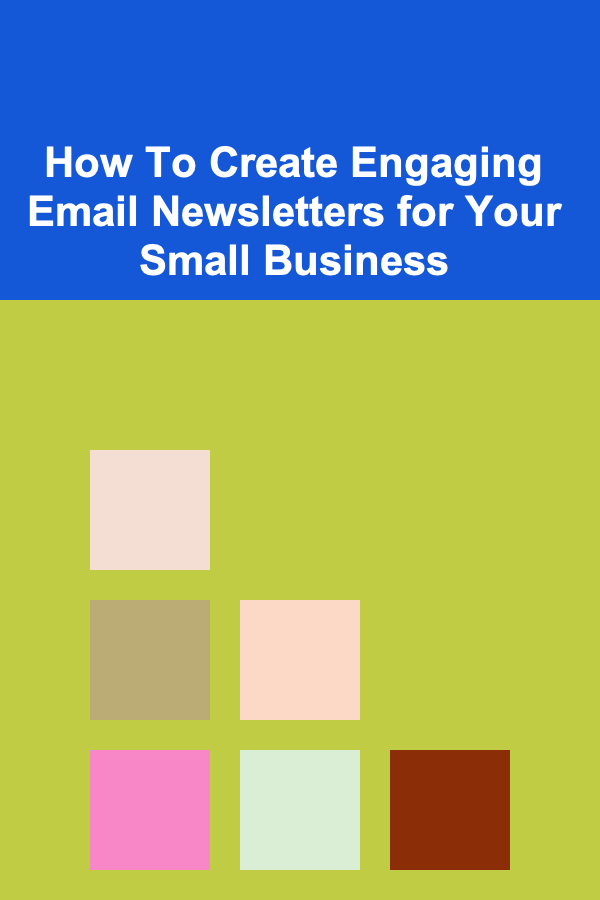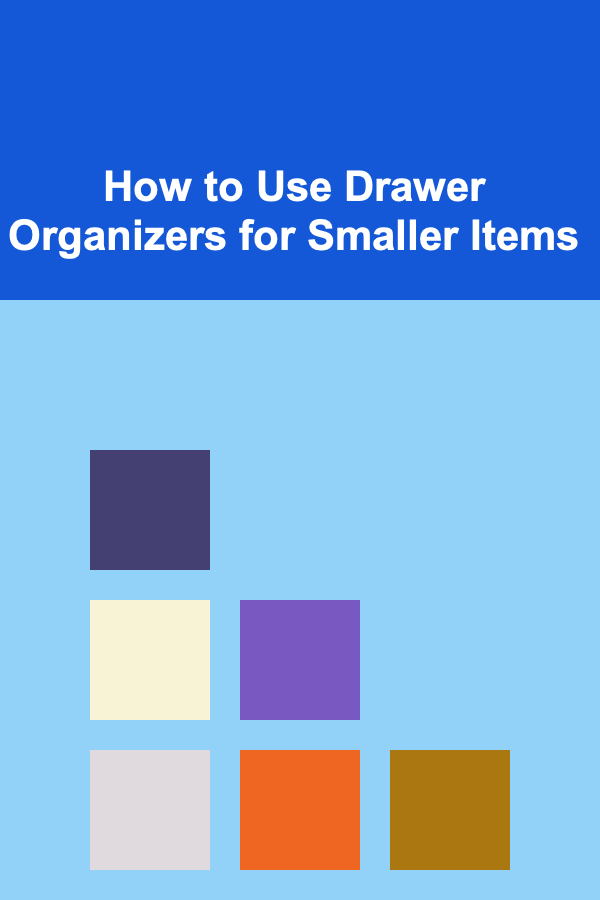
How To Create Engaging Email Newsletters for Your Small Business
ebook include PDF & Audio bundle (Micro Guide)
$12.99$5.99
Limited Time Offer! Order within the next:

Email newsletters remain one of the most effective ways to engage your audience, build relationships, and drive conversions for your small business. While social media platforms may offer quick ways to share updates, email allows for a more direct and personalized connection with your customers. However, simply sending out an email is not enough to guarantee success. Your newsletters must be engaging, informative, and visually appealing to capture the attention of your audience.
Creating engaging email newsletters for your small business involves a combination of strategy, design, content creation, and careful execution. This guide will walk you through the key steps and best practices for crafting newsletters that not only reach your audience but also inspire action and loyalty.
Understand Your Audience
Before diving into the design and content of your newsletter, it's essential to have a deep understanding of your audience. Knowing who your subscribers are will help you tailor your content, tone, and visuals to resonate with them.
Define Your Target Audience
For a small business, your audience is likely diverse, and understanding this diversity can help you personalize the content in a way that speaks directly to each segment. Ask yourself questions like:
- What are the demographics of my audience (age, gender, location, etc.)?
- What are their pain points and needs?
- What kind of products or services do they prefer?
By segmenting your audience based on these factors, you can create targeted emails that will be more engaging and relevant to each group.
Use Audience Data
Leverage data from your email platform to segment your audience effectively. Most email service providers (ESPs) offer tools for segmenting based on behaviors such as purchase history, email engagement, or even geographical location. Use this data to send tailored content that feels personalized, whether it's offering product recommendations, discounts, or updates that are relevant to the individual.
Craft a Compelling Subject Line
The subject line is arguably the most critical element of your email. It's the first thing your subscribers see and determines whether they'll open your newsletter. A compelling subject line grabs attention and entices the reader to click.
Keep It Short and Sweet
Most email clients cut off subject lines at around 50-60 characters, so aim to keep yours concise. A shorter subject line is easier to read and more likely to spark curiosity.
Personalize Your Subject Line
Personalization can significantly increase open rates. If possible, include the recipient's name or tailor the subject line to reflect their interests. For example, "Sarah, your exclusive offer is waiting!" or "New products just for you, John."
Be Clear and Specific
While being creative with subject lines is important, it's also essential to clearly convey the value of your email. Instead of vague phrases like "Check this out," be specific about what the recipient will find inside the email. For example, "10% off your next purchase" or "How to improve your SEO strategy."
Create a Sense of Urgency
Adding urgency to your subject line can prompt immediate action. Phrases like "limited time," "act now," or "ending soon" can motivate your subscribers to open your email and take action before it's too late.
Design Your Email Newsletter for Maximum Impact
Design is an essential component of an engaging email newsletter. An aesthetically pleasing layout, clear visuals, and user-friendly navigation all contribute to a positive experience for your subscribers.
Choose a Clean, Professional Template
The design of your newsletter should be simple, clean, and easy to navigate. Choose a professional template that aligns with your brand's identity and the overall tone of your business. Many email marketing platforms offer pre-designed templates that are mobile-responsive and customizable.
Use High-Quality Images
Images play a crucial role in catching the reader's eye and conveying your message. Use high-quality, relevant images that are consistent with your branding. Ensure that your images are optimized for email, meaning they should load quickly and not be too large in size, as this can slow down your email's load time and cause frustration for subscribers.
Keep Your Layout Organized
A well-organized layout improves the user experience and makes your content more digestible. Use clear headings, bullet points, and short paragraphs to break up text. Ensure that your call-to-action (CTA) buttons stand out and are easy to locate.
Use a Mobile-First Design
More than half of all emails are opened on mobile devices, so your email design should prioritize mobile-friendliness. Test your newsletter on multiple screen sizes to ensure it looks good on both desktop and mobile devices. Most ESPs provide mobile-responsive templates to help with this.
Write Engaging Content
Content is the backbone of your email newsletter. It's what keeps readers coming back for more and what motivates them to take action. The key to writing engaging content is to keep it relevant, valuable, and concise.
Focus on Value
Every piece of content you include in your newsletter should offer value to your subscribers. Whether it's a special promotion, helpful tips, or informative articles, your readers should feel that they are getting something useful from every email.
Be Consistent with Your Voice
Your email newsletter should reflect your brand's voice and personality. Whether your tone is friendly, professional, humorous, or authoritative, consistency is key. Establish a clear brand voice that resonates with your target audience and stick to it in every email you send.
Use Storytelling
People love stories. Instead of just listing your products or services, try weaving in some storytelling. Share a behind-the-scenes look at your business, tell customer success stories, or highlight an employee's achievements. Storytelling creates an emotional connection with your readers and makes your content more memorable.
Include Clear Calls to Action (CTAs)
Each newsletter should have a clear and compelling CTA that tells your readers what to do next. Whether it's "Shop Now," "Read More," "Learn More," or "Sign Up Today," make sure your CTA stands out and is easy to follow. Place it strategically within the content and ensure it aligns with the goal of your email.
Optimize for Deliverability
Even if you have the most engaging newsletter, it won't be effective if it never reaches your audience's inbox. To improve your deliverability, follow best practices for email marketing.
Maintain a Clean Email List
Regularly clean your email list to remove inactive subscribers, bounced email addresses, and spam traps. A clean email list ensures that your newsletters reach engaged readers and improves your sender reputation with email service providers.
Avoid Spammy Practices
Certain words or phrases can trigger spam filters, causing your emails to land in the spam folder instead of the inbox. Avoid using excessive capitalization, too many exclamation marks, or spammy phrases like "Free gift" or "100% guaranteed."
Set a Consistent Sending Schedule
Consistency is key when it comes to email marketing. Determine how often you will send newsletters (weekly, bi-weekly, or monthly) and stick to that schedule. Regular communication helps build trust with your audience and ensures that your brand remains top-of-mind.
Test and Analyze Your Emails
A/B testing is a great way to optimize your email newsletters. Test different subject lines, content formats, designs, and CTAs to see what works best for your audience. Most ESPs offer analytics that track open rates, click-through rates, and conversions, allowing you to measure the effectiveness of your campaigns and make improvements over time.
Personalize Your Newsletters
Personalization is a powerful tool in email marketing. Subscribers are more likely to engage with your emails when they feel that the content is tailored to their interests.
Segment Your Email List
As mentioned earlier, segmenting your email list allows you to send more relevant content to different groups of subscribers. You can segment your list based on demographics, purchase behavior, or engagement level. This way, you can send highly targeted emails that resonate with each group's specific needs and preferences.
Use Dynamic Content
Dynamic content allows you to personalize your emails based on a subscriber's behavior or preferences. For example, you can include product recommendations based on previous purchases or send a special discount on a subscriber's birthday. This level of personalization makes your emails feel more relevant and increases engagement.
Comply with Email Marketing Regulations
Ensure that your email newsletters comply with email marketing regulations such as the CAN-SPAM Act in the United States or GDPR in Europe. These laws are designed to protect consumers' privacy and ensure that businesses follow ethical practices.
Include an Unsubscribe Link
Always provide an easy way for recipients to unsubscribe from your emails. An unsubscribe link not only keeps you compliant with laws but also helps maintain a clean and engaged email list.
Obtain Consent
Ensure that you have explicit consent from subscribers before sending them marketing emails. This typically involves having subscribers opt-in to receive your newsletters rather than automatically adding them to your list.
Conclusion
Creating engaging email newsletters for your small business is a powerful way to connect with your audience, promote your products or services, and drive business growth. By understanding your audience, crafting compelling subject lines, designing beautiful layouts, writing valuable content, and optimizing your emails for deliverability, you can create newsletters that deliver real results.
Remember that email marketing is an ongoing process, and with consistent effort, creativity, and analysis, you can continually improve your email campaigns to achieve greater engagement, conversions, and customer loyalty.
Reading More From Our Other Websites
- [Home Budget 101] How to Save Money on Groceries While Maintaining a Healthy Diet
- [Home Lighting 101] How to Use Task Lighting for an Effective and Stylish Home Office
- [Home Lighting 101] How to Use LED Strip Lighting to Transform Your Home's Ambiance
- [Organization Tip 101] How to Create a Cozy Atmosphere in Shared Spaces
- [Home Space Saving 101] How to Maximize Space in Small Apartments Without Sacrificing Style
- [Scrapbooking Tip 101] Seasonal Scrapbooking Templates: From Holiday Cheer to Summer Memories
- [Toy Making Tip 101] From Sketch to Playtime: Designing Toys That Bring Stories to Life
- [Soap Making Tip 101] Must-Have Tools for Professional Soap Artisans
- [Organization Tip 101] How to Organize Your Camping Gear for Adventure Readiness
- [Personal Investment 101] How to Invest in Art and Collectibles as a Long-Term Asset

Dare to Dream: How to Stand Out by Pursuing Your Vision
Read More
How To Incorporate Cut-Out Details into Your Outfits
Read More
How to Organize Kids' Toys with Minimal Space
Read More
How to Organize Your Craft Supplies for Creative Flow
Read More
How to Reduce Grocery Costs Without Sacrificing Quality
Read More
How to Use Drawer Organizers for Smaller Items
Read MoreOther Products

Dare to Dream: How to Stand Out by Pursuing Your Vision
Read More
How To Incorporate Cut-Out Details into Your Outfits
Read More
How to Organize Kids' Toys with Minimal Space
Read More
How to Organize Your Craft Supplies for Creative Flow
Read More
How to Reduce Grocery Costs Without Sacrificing Quality
Read More